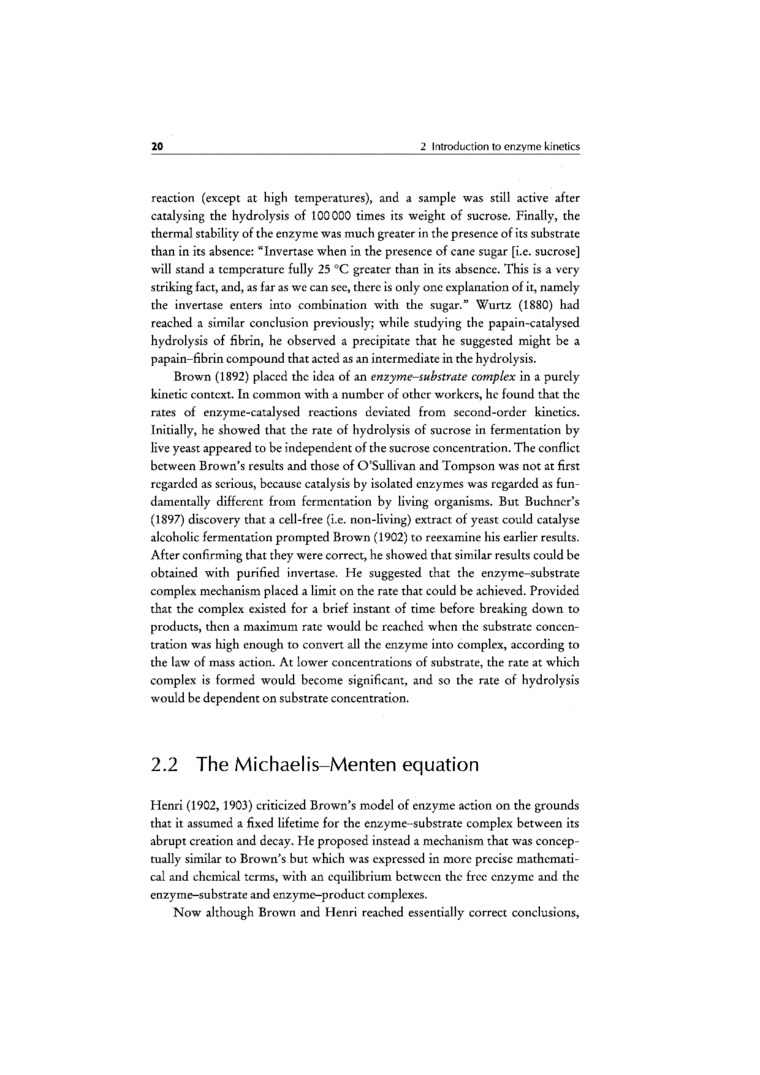107991

20
2 Inlroduction to cnzymc kinctics
reaction (except at high temperatures), and a sample was still active after catalysing thc hydrolysis of 100000 times its wcight of sucrosc. Finally, the thcrmal stability of thc cnzymc was much grcatcr in thc prescnce of its substratc than in its abscnce: “Invertase whcn in thc prcscnce of canc sugar [i.e. sucrosc] will stand a temperaturę fully 25 °C grcatcr than in its abscnce. This is a vcry striking fact, and, as far as wc can scc, thcrc is only one cxplanation of it, namcly the invertase enters into combination with the sugar.” Wurtz (1880) had reached a similar conclusion previously; while studying the papain-catalysed hydrolysis of fibrin, he obscrved a precipitate that hc suggested might bc a papain-fibrin compound that actcd as an intermediate in thc hydrolysis.
Brown (1892) placcd thc idea of an enzyme-substrate complex in a purcly kinetic contcxt. In common with a number of other workers, hc found that thc rates of enzyme-catalyscd rcactions dcviatcd from sccond-ordcr kinctics. Initially, he showed that the ratę of hydrolysis of sucrose in fermentation by live yeast appeared to be independent of the sucrose concentration. The conflict bctwccn Brown’s rcsults and those of 0’Sullivan and Tompson was not at first regarded as scrious, bccausc catalysis by isolatcd enzymes was regarded as fun-damcntally different from fermentation by living organisms. But Buchncr’s (1897) discovery that a cell-frec (i.e. non-living) cxtract of yeast could catalysc alcoholic fermentation prompted Brown (1902) to reexamine his earlier rcsults. After confirming that they were correct, he showed that similar results could be obtained with purified invertase. He suggested that the enzyme-substrate complex mechanism placcd a limit on the ratę that could be achieved. Provided that thc complcx cxistcd for a brief instant of time bcforc breaking down to products, then a maximum ratc would bc rcachcd whcn thc substratc concentration was high cnough to convcrt all thc cnzymc into complcx, according to the law of mass action. At lower conccntrations of substrate, thc ratę at which complex is formed would become significant, and so the ratę of hydrolysis would be dependent on substrate concentration.
2.2 The Michaelis-Menten equation
Henri (1902, 1903) criticized Brown's model of enzyme action on the grounds that it assumed a fixed lifetime for the enzyme-substrate complex between its abrupt creation and decay. He proposed instead a mechanism that was concep-tually similar to Brown's but which was cxprcsscd in morc prccisc mathemati-cal and chcmical terms, with an cquilibrium bctwccn thc frcc cnzymc and thc enzyme-substrate and cnzymc-product complcxcs.
Now akhough Brown and Henri reached essentially correct conclusions.
Wyszukiwarka
Podobne podstrony:
30 K. LASKA WIEC. M. PIOTROWICZ, P. ROMANOWSKI, P. WOYCIECHOWSKI atmosphere at standard temperaturę
1 (166) Strona 27 z 46 Spy Circuits corwert a high-voltage at low-current into a low-voltage at high
049 5 Blimp Connect the dots from 1 to 25. Color. •Os 23:T*20 22 These airships are often seen at sp
image007 MOVlNG? tf you want your GALAXY sub-scripcion scnt to a ncw address. notify ut at least FOU
skanuj0183 20 1. Co to jest strategia i zarządzanie strategiczne ścia do problematyki zarządzania st
TC A TO LIC KIE UROCZYSTOŚCI ZA AT LA NT YO KIE. 103 amerykańskich. Niejednokrotnie już biskupi Stan
więcej podobnych podstron